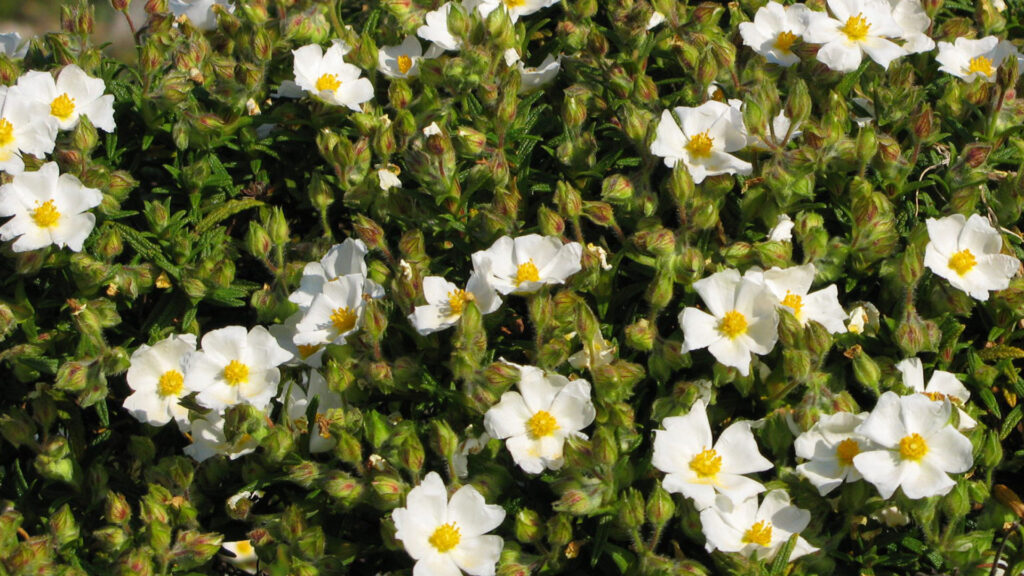
Cisto di Montpellier (CISTACEAE)
E’ un arbusto sempreverde , molto ramoso, vischioso e aromatico alto fino a 2 mt, con foglie lanceolate di colore verde scuro e fiori bianchi in gruppi di 3/8 a volte con sfumature giallastre.
I frutti che contengono i semi si presentano come delle capsule appiattite e pelose nella parte superiore. Noto anche come cisto marino ha un ciclo vegetativo autunno-primaverile periodo che culmina con la fioritura, predilige terreni argillosi e si può’ trovare dal mare fino a mille mt di altitudine. Soprattutto al caldo da queste arbusti si spandono olii eterei che insieme all’ elicriso caratterizzano le estati sarde.
E’ una pianta pioniera che colonizza le aree percorse da incendi , i quali ne favoriscono la germinazione dei semi pertanto i cisteti prevengono l’erosione dei pendii collinari e montuosi e rappresentano uno degli ultimi baluardi contro la desertificazione. Sono inoltre l’habitat ideale per molti funghi tra cui il “boleto del cisto”, apprezzato e venduto in Sardegna.
Dalle foglie si estrae una resina il “LODANO” usato come fissativo e molto importante per la preparazione di profumi. Un tempo veniva sradicato e sistemato in fascine (fascia de mudegu), e utilizzato come combustibile per alimentare i forni familiari per la cottura del pane e dei dolci.
Conosciuta fin dai tempi degli antichi egizi e nell’antica Grecia veniva impiegata come rimedio naturale per contrastare bronchiti, dolori reumatici come gastroprotettore, e per le sue proprietà’ antii nfiammatorie grazie alla presenza dei plifenoli.
Cistus of Montpellier (CISTACEAE)
It is an evergreen shrub, very branchy, viscous and aromatic up to 2 meters high, with dark green lanceolate leaves and white flowers in groups of 3/8 sometimes with yellowish shades.
The fruits that contain the seeds appear as flattened and hairy capsules in the upper part. Also known as sea cistus, it has an autumn-spring vegetative cycle period that culminates with flowering, prefers clayey soils and can be found from the sea up to a thousand meters above sea level. Especially in the heat from these shrubs ethereal oils spread which together with the helichrysum characterize the Sardinian summers.
It is a pioneer plant that colonizes the areas covered by fires, which favor the germination of seeds, therefore the cisteti prevent the erosion of the hilly and mountainous slopes and represent one of the last bastions against desertification. They are also the ideal habitat for many mushrooms including the “boleto del cisto”, appreciated and sold in Sardinia From the leaves a resin is extracted, the “LODANO” used as a fixative and very important for the preparation of perfumes.
It was once uprooted and placed in bundles (fascia de mudegu), and used as fuel to feed the family ovens for baking bread and sweets. Known since the times of the ancient Egyptians and in ancient Greece it was used as a natural remedy to combat bronchitis, rheumatic pain as a gastroprotector, and for its anti-inflammatory properties thanks to the presence of plifenols.
Ciste de Montpellier (CISTACÉES)
C’est un arbuste persistant, très branchu, visqueux et aromatique pouvant atteindre 2m de haut, aux feuilles lancéolées vert foncé et aux fleurs blanches par groupe de 3/8 parfois aux nuances jaunâtres.
Les fruits qui contiennent les graines se présentent sous forme de capsules aplaties et poilues dans la partie supérieure.Très connu également sous le nom de ciste de mer, il a un cycle végétatif automne-printemps période qui culmine avec la floraison, préfère les sols argileux et se trouve pratiquement partout, de la mer jusqu’à mille mètres d’altitude. Ils préfèrent avant tout à la chaleur de ces arbustes qu’ils répandent des huiles éthérées qui, avec l’hélichryse, caractérisent les étés sardes.
C’est une plante pionnière qui colonise les zones traversées par les incendies, qui favorisent la germination des graines, ainsi les citernes empêchent l’érosion des pentes vallonnées et montagneuses et représentent l’un des derniers remparts contre la désertification. Ils sont aussi l’habitat idéal de nombreux champignons dont le “boleto del cisto”, apprécié et vendu en Sardaigne. Des feuilles est extraite une résine, la “LODANO” utilisée comme fixateur et très importante pour la préparation des parfums.
À une époque très lointaine, il a été déraciné et mis en bottes (fascia de mudegu), et utilisé comme combustible pour alimenter les fours familiaux pour la cuisson du pain et des sucreries. Connu depuis l’époque des anciens Égyptiens et dans la Grèce antique, il était utilisé comme remède naturel, pour lutter contre la bronchite, les douleurs rhumatismales comme gastroprotecteur, et pour ses propriétés anti-inflammatoires grâce à la présence de polyphénols.

